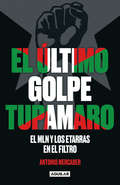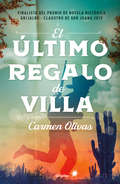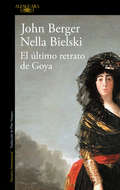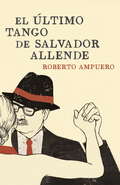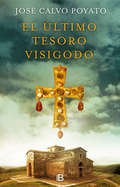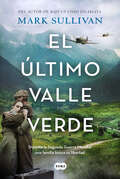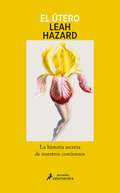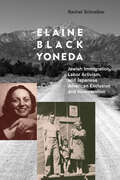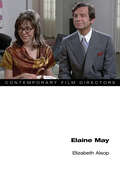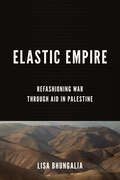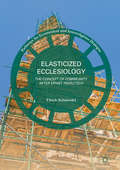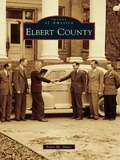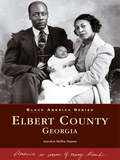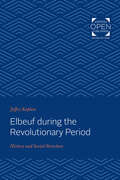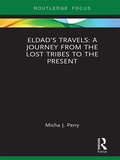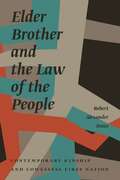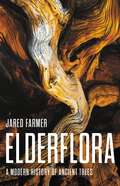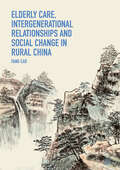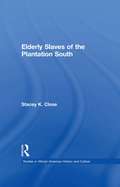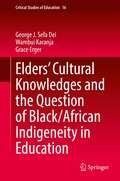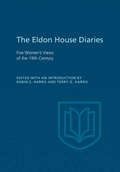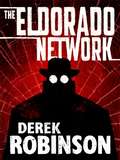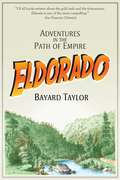- Table View
- List View
El último golpe tupamaro: El MLN y los etarras en El Filtro
by Antonio MercaderUn libro polémico, que sin duda despertará opiniones encontradas. Uruguay es el único país en donde cada año se realiza un acto público a favor de la ETA, mientras en otros se hacen manifestaciones masivas de protesta contra sus crímenes. Los manifestantes marchan por bulevar Artigas, desde el Obelisco al ex hospital Filtro, en recuerdo de aquella jornada con una víctima fatal. Este libro indaga en ese episodio de la historia reciente, cuyas consecuencias se hacen sentir hasta hoy, y lo conecta directamente con el accionar tupamaro. A comienzos de los años noventa, quince miembros de la banda llegaron a Uruguay e instalaron un par de restaurantes de comida vasca. A instancias del gobierno español de Felipe González, se pidió la extradición de ocho de ellos. La Justicia uruguaya concedió solo tres, de activistas acusados de homicidios, entre muchos delitos. El proceso judicial insumió dos años, lapso en el cual el Frente Amplio y el PIT-CNT desarrollaron una estentórea campaña para que se negara la extradición. Tres etarras en huelga de hambre –que después se com-probaría no era tal– fueron internados en el hospital Filtro. Grupos de izquierda, en particular los tupamaros, instalaron un campamento para resistir las extradiciones. El expresidente José Mujica y su posterior ministro de Interior, Eduardo Bonomi, fueron quienes convocaron a la marcha. El Movimiento de Liberación Nacional (MLN) convenció al Frente Amplio, y en especial a Tabaré Vázquez, de concurrir a la manifestación. En palabras del exjefe tupamaro Jorge Zabalza, aquel enfretamiento armado sirvió de entrenamiento para “los jóvenes radicales deseosos de tener su bautismo de fuego”. Allí volaron piedras y sonaron disparos, los que motivaron una respuesta policial que dejó como trágico saldo un manifestante muerto y dos docenas de heridos. En este libro, que se publica póstumamente, Antonio Mercader narra los hechos de esa fatídica marcha violenta en plena democracia. Demuestra la relación de los tupamaros con los etarras y cómo se sumaron esfuerzos para atentar contra un fallo judicial y un gobierno democrático. Describe cómo los tupamaros practicaban un doble juego: por una parte, eran un grupo político que postulaba a legisladores para integrar el Parlamento democrático, y por otra, seguían cometiendo delitos. A partir del fracaso del Filtro, “el último golpe tupamaro”, optaron por abandonar la vía criminal que habían iniciado en 1963.
El último regalo de Villa
by Carmen Olivas"Entonces comprendí por qué llamaban a Villa el Centauro: hombre y bestia eran una sola cosa, fundidos por la rabia y el valor". Valentín. Valentín, con solo doce años, le hace una promesa a su madre en su lecho de muerte: ir en busca de su padre, quien, unos años antes, se unió a las filas villistas. La División del Norte pasa por el pueblo del muchacho y éste, en un arranque de valentía, se acerca sin dudarlo al mismísimo Centauro. Comienza así un periplo de aventuras y aprendizajes, en el que Valentín deberá demostrar que ha entrado, aunque a marchas forzadas, en la edad adulta. ¿Encontrará a su progenitor? ¿Comprenderá el valor de alzarse en armas por la causa revolucionaria? ¿Cuál será el detino de la bola en esos últimos días aciagos en el norte del país? A través de la mirada entrañable del propio Valentín, iremos conociendo sus pugnas internas, miedos y arrebatos, así como a un Pancho Villa más humano, quien, además de general, fue un padre para todos aquellos que lucharon por la Revolución.
El último retrato de Goya
by John Berger Nella BielskiEl último retrato de Goya está inspirado en diversos episodios de la vida del artista, en una época de agitación política y guerras patrióticas. Durante el largo periodo de caos que marcó en España el salto de siglos entre el XVIII y el XIX, en una época de agitación política y guerras patrióticas, Francisco de Goya tuvo que ganarse la vida como pintor de Corte, haciendo retratos de familia real y de la aristocracia. Pero su retrato más importante quizá no sea ninguno de ellos, sino el fenomenal retablo que integran sus dibujos y grabados, hasta pintar el rostro monstruoso y revuelto de su tiempo. El último retrato de Goya está inspirado en diversos episodios de la vida del artista. Es, por así decirlo, una serie de diálogos de alto contenido iconográfico, la antítesis de una «comedia de época». Los autores, dando réplica al genio inventivo y a la tremenda expresividad de Goya, trazan una semblanza del pintor que nos lo sitúa en su tiempo sin dejar de presentárnoslo como un hombre que nos habla desde el presente, como si hubiera conocido nuestros problemas actuales, como si hubiera pintado el futuro.
El último tango de Salvador Allende
by Roberto AmpueroNadie responde en la casa de los comandantes en jefe de las Fuerzas Armadas y todo indica que el golpe de Estado está en marcha. Salvador Allende se dirige a palacio. Y Rufino, asistente personal del presidente, viejo compañero de un taller anarquista, gran amante del tango ?afición que comparte con el mandatario?, escribe en un cuaderno escolar la historia de la tragedia que se avecina. Muchos años después, ya derrumbados los muros de la Guerra Fría, ese mismo cuaderno ve la luz cuando inesperadamente llega a las manos de David Kurtz, exagente de la CIA, quien a través de sus páginas irá descubriendo no solo la vida íntima del presidente, sino también secretos inimaginables de su propio pasado. Con talento y maestría, Roberto Ampuero nos entrega una novela apasionante sobre la lealtad y la traición, la honestidad y la impudicia, el amor y el desamor, el bien y el mal que se cuelan en el alma y la historia de los hombres.
El último tesoro visigodo
by José Calvo PoyatoUna novela llena de acción, amor y ambición, escrita con la maestría literaria, la claridad de ideas y el exquisito rigor histórico de Jose Calvo Poyato. Toledo, 1858. Un labriego encuentra de manera fortuita una colección de cruces y piezas que parecen coronas, todas trabajadas en oro puro y cuajadas de piedras preciosas. Aunque su descubridor no puede imaginar su verdadero valor, la noticia pronto llegará a oídos expertos que no dejarán pasar la oportunidad de hacerse con la fortuna que este tesoro arqueológico significa. Una trama que corre a ritmo de thriller de la mano de personajes memorables y se complementa con escenas de la época visigoda para llevar al lector a entender el origen del fabuloso Tesoro de Guarrazar y la asombrosa aventura que llevó estas magníficas obras de orfebrería hasta manos francesas. La historia detrás de uno de los grandes tesoros arqueológicos de España. Su hallazgo y la codicia que desató a su alrededor. El expolio que generó ambiciones desmedidas. La crítica ha dicho sobre El espía del rey...«Calvo Poyato recupera a Jorge Juan, espía audaz, leal, astuto, en una novela de acción e intriga que nadie debería perderse.»Santiago Posteguillo «Mezcla de intriga, aventuras y ciencia espléndidamente ambientada.»Librería Gaztambide «Fascinante.»Nacho Ares, SER Historia «Magistral.»José Luis Corral «El rigor histórico se funde con la intriga en una trama que no da tregua.»Librería París «Una estupenda novela del siglo XVIII español y una lección de Historia.»Librería Luque «Del panorama literario actual, José Calvo Poyato es uno de los autores que mejor nos traslada a épocas pasadas.»Onda Cero «Tan apasionante como una novela de John Le Carré.»David Yagüe, 20 minutos «Un referente de la novela histórica española.»El Periódico
El último tesoro visigodo
by José Calvo PoyatoUna novela llena de acción, amor y ambición, escrita con la maestría literaria, la claridad de ideas y el exquisito rigor histórico de Jose Calvo Poyato. Toledo, 1858. Un labriego encuentra de manera fortuita una colección de cruces y piezas que parecen coronas, todas trabajadas en oro puro y cuajadas de piedras preciosas. Aunque su descubridor no puede imaginar su verdadero valor, la noticia pronto llegará a oídos expertos que no dejarán pasar la oportunidad de hacerse con la fortuna que este tesoro arqueológico significa. Una trama que corre a ritmo de thriller de la mano de personajes memorables y se complementa con escenas de la época visigoda para llevar al lector a entender el origen del fabuloso Tesoro de Guarrazar y la asombrosa aventura que llevó estas magníficas obras de orfebrería hasta manos francesas. La historia detrás de uno de los grandes tesoros arqueológicos de España. Su hallazgo y la codicia que desató a su alrededor. El expolio que generó ambiciones desmedidas. La crítica ha dicho sobre El último tesoro visigodo...«Llena de intriga e historia, con una estupenda ambientación, muy bien documentada.»De lector a lector«Combina con sabiduría la novela histórica y el thriller.»Juan Ángel Juristo, ABC«Un homenaje a una época olvidada de la historia de España: los visigodos.»Alejandra Luque, El MundoLa crítica ha dicho sobre El espía del rey...«Calvo Poyato recupera a Jorge Juan, espía audaz, leal, astuto, en una novela de acción e intriga que nadie debería perderse.»Santiago Posteguillo«Mezcla de intriga, aventuras y ciencia espléndidamente ambientada.»Librería Gaztambide«Fascinante.»Nacho Ares, SER Historia«Magistral.»José Luis Corral«El rigor histórico se funde con la intriga en una trama que no da tregua.»Librería París«Una estupenda novela del siglo XVIII español y una lección de Historia.»Librería Luque«Del panorama literario actual, José Calvo Poyato es uno de los autores que mejor nos traslada a épocas pasadas.»Onda Cero«Tan apasionante como una novela de John Le Carré.»David Yagüe, 20 minutos«Un referente de la novela histórica española.»El Periódico
El último valle verde
by Mark SullivanDel autor de Bajo un cielo escarlata, una nueva novela histórica inspirada por la increíble historia de coraje y supervivencia de una familia para escapar de Ucrania durante la Segunda Guerra Mundial. A finales de marzo de 1944, a medida que las tropas soviéticas se adentran en Ucrania, Emil y Adeline Martel se ven obligados a tomar una agónica decisión: ¿deben esperarlas y arriesgarse a ser enviados a Siberia? ¿O seguir a regañadientes a los peligrosos oficiales nazis que han jurado protegerlos? Los Martel son una de las muchas familias de ascendencia alemana cuyos antepasados han trabajado la tierra en Ucrania durante más de un siglo. Pero tras vivir bajo el régimen de terror de Stalin, la joven pareja decide que su mejor opción es huir en retirada junto a los nazis, a los que desprecian, para escapar de los soviéticos en busca de su libertad. Atrapados entre dos fuerzas en lucha y enfrentados a terribles dificultades para lograr su objetivo de llegar al oeste, la historia de los Martel es un emocionante, desgarrador y, finalmente, esperanzador relato que ilumina el extraordinario poder del amor y de los sueños y la increíble voluntad de sobrevivir de una familia. Sobre la novela han dicho:«¡Mark Sullivan lo ha vuelto a lograr! El último valle verde es una absorbente e inspiradora historia de heroísmo y coraje en los oscuros días al final de la Segunda Guerra Mundial».Kristin Hannah, autora de El Ruiseñor «Mark Sullivan entreteje historia y memoria en un épico viaje de amor y resiliencia. Uno de los libros más fascinantes y adictivos que he leído en mucho tiempo».Heather Morris, autora de El tatuador de Auschwitz «Sullivan demuestra de nuevo su don para encontrar rescoldos de historia poco conocidos e insuflarles vida hasta que brillan y resplandecen de un modo emocionante y a la vez memorable».Pam Jenoff, autora de El vagón de los huérfanos «Tras su exitosa novela Bajo un cielo escarlata, Mark Sullivan llega con otra deslumbrante proeza. El último valle verde noveliza una inspiradora historia real de fortaleza, fe y resistencia».Authorlink «Sullivan tiene una extraordinaria imaginación que se une a un verdadero talento para crear escenas realistas, tanto de estremecedores episodios de peligro como de íntimos momentos de dolor».Historical Novel Society «Si te gustan las novelas históricas, esta es una de las mejores que se publicarán este año... o cualquier año».Red Carpet Crash «Una lectura simplemente cautivadora de la primera a la última página».Midwest Book Review «Mark Sullivan lo ha vuelto a conseguir: toma historias muy reales y muy humanas ambientadas en el periodo más intenso de la historia reciente y nos ofrece una novela histórica que tardaremos mucho en olvidar».Bookreporter
El útero: La historia secreta de nuestros comienzos
by Leah HazardUna innovadora investigación sobre el órgano más incomprendido del cuerpo femenino Pionero, imprescindible y muy recomendable, El útero: La historia secreta de nuestros comienzos es una extraordinaria indagación sobre un órgano femenino poco investigado, un libro escrito con sabiduría y calidez que combina los años de experiencia de la autora como comadrona con la historia de la medicina, los últimos descubrimientos científicos y la investigación periodística. Hazard examina los prejuicios culturales y las suposiciones que han hecho que el útero sea tan mal comprendido y ofrece una visión clara, inclusiva y desmitificadora de un órgano esencial. La crítica ha dicho:«Leah Hazard aborda un tema fascinante con pericia profesional y una inmensa empatía».Hilary Mantel «Un libro humano, inteligente, accesible y lleno de ideas fascinantes».The Guardian «Un texto muy bien argumentado y profundamente empático. Una exploracióndeslumbrante sobre la ciencia del útero, los caminos de la medicina y el futuro de la ciencia reproductiva».New Statesman «Todos los historiadores de la medicina se sorprenderán ante las revelaciones de Hazard».The New York Times «Compasiva y convincente, […] revela la importancia de comprender el útero para la autonomía corporal, la justicia reproductiva y los derechos humanos. Un libro fenomenal».Elinor Cleghorn«Una biografía fascinante de un órgano muy denostado. El útero es agudo y político, erudito y sabio, y urgente y necesario. Por encima de todo, Leah Hazard es una narradora brillante. Me ha encantado».Katherine May
Elaine Black Yoneda: Jewish Immigration, Labor Activism, and Japanese American Exclusion and Incarceration
by Rachel SchreiberDuring World War II, Elaine Black Yoneda, the daughter of Russian Jewish immigrants, spent eight months in a concentration camp—not in Europe, but in California. She did this voluntarily and in solidarity, insisting on accompanying her husband, Karl, and their son, Tommy, when they were incarcerated at the Manzanar Relocation Center. Surprisingly, while in the camp, Elaine and Karl publicly supported the United States’ decision to exclude Japanese Americans from the coast. Elaine Black Yoneda is the first critical biography of this pioneering feminist and activist. Rachel Schreiber deftly traces Yoneda’s life as she became invested in radical politics and interracial and interethnic activism. In her work for the International Labor Defense of the Communist Party, Yoneda rose to the rank of vice president. After their incarceration, Elaine and Karl became active in the campaigns to designate Manzanar a federally recognized memorial site, for redress and reparations to Japanese Americans, and in opposition to nuclear weapons. Schreiber illuminates the ways Yoneda’s work challenged dominant discourses and how she reconciled the contradictory political and social forces that shaped both her life and her family’s. Highlighting the dangers of anti-immigrant and anti-Asian xenophobia, Elaine Black Yoneda recounts an extraordinary life.
Elaine May (Contemporary Film Directors)
by Elizabeth AlsopA master of subverting tropes with surgical precision, Elaine May forged a career in 1970s Hollywood with films like The Heartbreak Kid and Mikey and Nicky. Elizabeth Alsop explores the director’s non-conformist and uncompromising vision while looking at May’s films against trends in classic and post-classical Hollywood. Shaped by her background and success in the theater, May brought the biting humor of her improv comedy to her filmmaking. But unfriendly media and a system hostile to both her methods and sensibility consigned her to “director’s jail” after the failure of Ishtar. As Alsop moves through the filmmaker’s four movies, she tracks May’s inventive treatment of favorite themes like hapless male characters and the inanities of American culture. She also considers May’s work in relation to her multifaceted career as a writer and performer. A compelling reconsideration of an iconoclast and original, Elaine May reveals how a surprisingly radical auteur created her trademark cinema of discomfort.
Elastic Empire: Refashioning War through Aid in Palestine (Stanford Studies in Middle Eastern and Islamic Societies and Cultures)
by Lisa BhungaliaThe United States integrated counterterrorism mandates into its aid flows in the West Bank and Gaza Strip during the early years of the global war on terror. Some two decades later, this securitized model of aid has become normalized across donor intervention in Palestine. Elastic Empire traces how foreign aid, on which much of the Palestinian population is dependent, has multiplied the sites and means through which Palestinian life is regulated, surveilled, and policed—this book tells the story of how aid has also become war. Drawing on extensive research conducted in Palestine, Elastic Empire offers a novel accounting of the US security state. The US war chronicled here is not one of tanks, grenades, and guns, but a quieter one waged through the interlacing of aid and law. It emerges in the infrastructures of daily life—in a greenhouse and library, in the collection of personal information and mapping of land plots, in the halls of municipal councils and in local elections—and indelibly transfigures lives. Situated in a landscape where the lines between humanitarianism and the global war on terror are increasingly blurred, Elastic Empire reveals the shape-shifting nature of contemporary imperial formations, their realignments and reformulations, their haunted sites, and their obscured but intimate forms.
Elasticized Ecclesiology
by Ulrich SchmiedelThis study confronts the current crisis of churches. In critical and creative conversation with the German theologian Ernst Troeltsch (1865-1923), Ulrich Schmiedel argues that churches need to be "elasticized" in order to engage the "other. " Examining contested concepts of religiosity, community, and identity, Schmiedel explores how the closure of church against the sociological "other" corresponds to the closure of church against the theological "other. " Taking trust as a central category, he advocates for a turn in the interpretation of Christianity--from "propositional possession" to "performative project," so that the identity of Christianity is "done" rather than "described. " Through explorations of classical and contemporary scholarship in philosophy, sociology, and theology, Schmiedel retrieves Troeltsch's interdisciplinary thinking for use in relation to the controversies that encircle the construction of community today. The study opens up innovative and instructive approaches to the investigation of the practices of Christianity, past and present. Eventually, church emerges as a "work in movement," continually constituted through encounters with the sociological and the theological "other. "
Elbert County (Images of America)
by Joyce M. DavisEstablished in 1790, Elbert County was carved from adjacent Wilkes County and named in honor of American patriot and former governor Samuel Elbert. Located in Northeast Georgia on the Savannah and Broad Rivers, the territory witnessed Revolutionary War fighting and the creation of Fort James, Dartmouth, and Petersburg, occurring all before 1790. Later Ruckersville, Heardmont, Bowman, and Dewy Rose were established. Elberton, chosen as county seat by former governor Stephen Heard's committee, was incorporated in 1803 and dominated county history thereafter. Nancy Hart and Stephen Heard, among others, aided the revolution; merchants William and Beverly Allen forged a business path; and preachers, including Dozier Thornton, established many county churches. In later years, Corra Harris, born at Farmhill, attended Elberton Female Academy before becoming a noted writer. In the 20th century, cotton production was overshadowed by the growth of granite quarrying and finishing, leading to Elberton becoming the "Granite Capital of the World."
Elbert County, Georgia (Black America Series)
by Aurolyn Melba HammElbert County, the granite capital of the world, is nestled in the northeast corner of Georgia, in the foothills of the Appalachian Mountains. The educational and political journey of many African Americans in this county began at Elbert Colored High School. African Americans in Elbert County helped shape their community and their country through sheer determination and faith, in the face of slavery and laws biased against them.
Elbeuf during the Revolutionary Period: History and Social Structure (The Johns Hopkins University Studies in Historical and Political Science)
by Jeffry KaplowOriginally published in 1964. Jeffry Kaplow investigates the effects of the French Revolution on life in Elbeuf, a textile town in Normandy, through a social-historical lens. A careful study of local demographic, fiscal, and tax records allows him to reconstruct the social structure of Elbeuf's population on the eve of the French Revolution and to make claims about its economy, which was based on wool production. Somewhat unusually, there was no strong noble or clerical presence in Elbeuf, which was dominated by wool manufacturers. Despite the destabilizing effects of the Revolution, which included an economic downturn and an inflamed sense of grievance among less wealthy local constituencies, the bourgeoisie retained its grip on power in Elbeuf and its environs throughout this period. With the support of extensive archival evidence, Kaplow goes to great lengths to model the particular social and economic conditions that allowed this town to avoid succumbing to the tumult of the Revolution and to undergo, in fact, so little change compared with most municipalities of the country.
Eldad’s Travels: A Journey from the Lost Tribes to the Present
by Micha J PerryIn the latter years of the ninth century, a mysterious figure arrived in the North African Jewish community of Kairouan. The visitor, Eldad of the tribe of Dan, claimed to have arrived from the kingdom of the Israelite tribes whose whereabouts had been lost for over a millennium and a half. Communicating solely in Hebrew, the sojourner’s vocabulary contained many words that were unfamiliar to his hosts. This enigmatic traveler not only baffled and riveted the local Jewish community but has continued to grip audiences and influence lives into the present era. This book takes stock of the long journey that both Eldad and his writings have made through Jewish and Christian imaginations from the moment he stepped foot in North Africa to the turn of the new millennium. Each of its chapters assays a major leg of this voyage, offering an in-depth look at the original source material and shedding light on the origins and later reception of this elusive character.
Elder Brother and the Law of the People: Contemporary Kinship and Cowessess First Nation
by Robert Alexander InnesIn the pre-reserve era, Aboriginal bands in the northern plains were relatively small multicultural communities that actively maintained fluid and inclusive membership through traditional kinship practices. These practices were governed by the Law of the People as described in the traditional stories of Wîsashkêcâhk, or Elder Brother, that outlined social interaction, marriage, adoption, and kinship roles and responsibilities.In Elder Brother and the Law of the People, Robert Innes offers a detailed analysis of the role of Elder Brother stories in historical and contemporary kinship practices in Cowessess First Nation, located in southeastern Saskatchewan. He reveals how these tradition-inspired practices act to undermine legal and scholarly definitions of “Indian” and counter the perception that First Nations people have internalized such classifications. He presents Cowessess’s successful negotiation of the 1996 Treaty Land Agreement and their high inclusion rate of new “Bill-C31s” as evidence of the persistence of historical kinship values and their continuing role as the central unifying factor for band membership.Elder Brother and the Law of the People presents an entirely new way of viewing Aboriginal cultural identity on the northern plains.
Elderflora: A Modern History of Ancient Trees
by Jared FarmerThe epic story of the planet&’s oldest trees and the making of the modern world Humans have always revered long-lived trees. But as historian Jared Farmer reveals in Elderflora, our veneration took a modern turn in the eighteenth century, when naturalists embarked on a quest to locate and precisely date the oldest living things on earth. The new science of tree time prompted travelers to visit ancient specimens and conservationists to protect sacred groves. Exploitation accompanied sanctification, as old-growth forests succumbed to imperial expansion and the industrial revolution. Taking us from Lebanon to New Zealand to California, Farmer surveys the complex history of the world&’s oldest trees, including voices of Indigenous peoples, religious figures, and contemporary scientists who study elderflora in crisis. In a changing climate, a long future is still possible, Farmer shows, but only if we give care to young things that might grow old.
Elderly Care, Intergenerational Relationships and Social Change in Rural China
by Fang CaoThis book investigates how rapid socio-political-economic change in China since 1949 has affected intergenerational relationships and practices in rural areas, specifically the care provided to elderly parents by their adult children. It focuses on the lived experiences of rural villagers and their perceptions of the impact of these socio-political changes on intergenerational relationships, care of the elderly, family cohesion, and the traditional value of filial piety. It notably considers the importance of filial piety as a dominant family value, the conflict between strong family bonds and growing desires for individuality and autonomy, the prevalence of migrant work among adult children and the diversification of intergenerational practices, alongside the need for national policy and services development for residential and community-based aged care in rural China.
Elderly Slaves of the Plantation South (Studies in African American History and Culture)
by Stacey K. CloseFirst published in 1997. Routledge is an imprint of Taylor & Francis, an informa company.
Elders’ Cultural Knowledges and the Question of Black/ African Indigeneity in Education (Critical Studies of Education #16)
by George J. Dei Wambui Karanja Grace ErgerThis book makes a strong case for the inclusion of Indigenous Elders’ cultural knowledge in the delivery of inclusive education for learners who are members of minority communities. It is relevant to curriculum developers, teachers, policy makers and institutions that engage in the education of Black, Indigenous, Latinx and other minority students. This book provides opportunities for exploring the decolonization of educational approaches. It promotes the synthesis of multiple types of knowledge and ways of knowing by making a case for the incorporation of Indigenous knowledges and Indigenous Elders as teachers in learning spaces. The book is of interest to educators, students, and researchers of Indigenous knowledge and decolonizing education. Additionally, it is important for educational policy makers, especially those engaged in looking for strategic solutions to bridging educational disparities and gaps for Indigenous, Black, Latinx and other minority learners.
Eldon House Diaries: Five Women's Views of the 19th Century
by Robin Harris Terry HarrisEldon House is a distinctive element in the historical townscape of London, Ontario. By the mid-nineteenth century, its original owners, John and Amelia Harris, were prominent members of society in that dynamic community. Their children grew up in the affluent and cultured setting of a family whose increasing prosperity advanced with that of London and western Ontario. If London had an elite, the Harris family was part of it, and Eldon House was an important focal point of the social regimen of the day. A considerable corpus of family papers within the Eldon House and prominent among these papers is a collection of diaries that are excerpted in this volume, encapsulating the personalities, activities, and voices of the Harrises of London. These diaries are valuable because of the details of the warp and woof of daily life in the nineteenth century. But, more importantly, they are women's diaries. As such, they speak to us of the verities of personal, domestic, and societal life in the neglected voice of women. Together, they provide a fascinating perspective of these women's lives in, around, and beyond Eldon House.
Eldorado Network
by Derek Robinson1941. Hitler rampant. Spain neutral. Madrid, like Casablanca, the launching pad for spies from all sides. The most daring and audacious is codenamed 'Eldorado'. Young, inexperienced, hotheaded, he had no right to survive, let alone succeed. Now his network is the most valuable in Europe, and the fates of armies lie in his hands.But who does he work for? Or is he only in it for himself? One thing's for sure. War may be a dirty business, but it certainly brings home the bacon. Based on a true story, The Eldorado Network is the first novel in Derek Robinson's acclaimed Luis Cabrillo Quartet. A tense and gripping espionage thriller from a master of action and suspense.
Eldorado Network
by Derek Robinson1941. Hitler rampant. Spain neutral. Madrid, like Casablanca, the launching pad for spies from all sides. The most daring and audacious is codenamed 'Eldorado'. Young, inexperienced, hotheaded, he had no right to survive, let alone succeed. Now his network is the most valuable in Europe, and the fates of armies lie in his hands.But who does he work for? Or is he only in it for himself? One thing's for sure. War may be a dirty business, but it certainly brings home the bacon. Based on a true story, The Eldorado Network is the first novel in Derek Robinson's acclaimed Luis Cabrillo Quartet. A tense and gripping espionage thriller from a master of action and suspense.
Eldorado: Adventures in the Path of Empire (Notable American Authors)
by Bayard TaylorA journalist's eyewitness account of the explosive 1849 California gold rush and his travels through Mexico. In 1849, a young, wide-eyed reporter from New York ventured West not to seek riches, but to report on the madness and exuberance of the California gold rush. Sent by Horace Greeley, a highly respected New-York Tribune editor, twenty-four-year-old Bayard Taylor traveled through Panama to reach his final destination, San Francisco, which he described as an "amphitheatre of fire" in the night, gleaming with the promise of gold and progress.In his enthralling and robust narrative, Bayard brings the reader into the wild, lush world of early California, reporting on the nearly overnight growth of townships and infrastructure after the gold rush. During his adventures, Bayard walked one hundred miles from San Francisco to Monterey, and later returned to New York via Mexico by foot, mule, and coach. Bayard describes the characters he met with an honest curiosity--heady gold miners who had once been doctors and lawyers, hospitable Mexicans from all classes of society, and even a highway robber who made off with his books.Eldorado, which borrows its title from the South American-Spanish legend of a hidden land of gold, is a magnificent tale about the birth of California from a deserted land to a modern city sprawl. At once an account of history and of one man's thrilling adventures, Eldorado transports the reader to the beginning of an era, with all its gold, glitz, and glamour.
